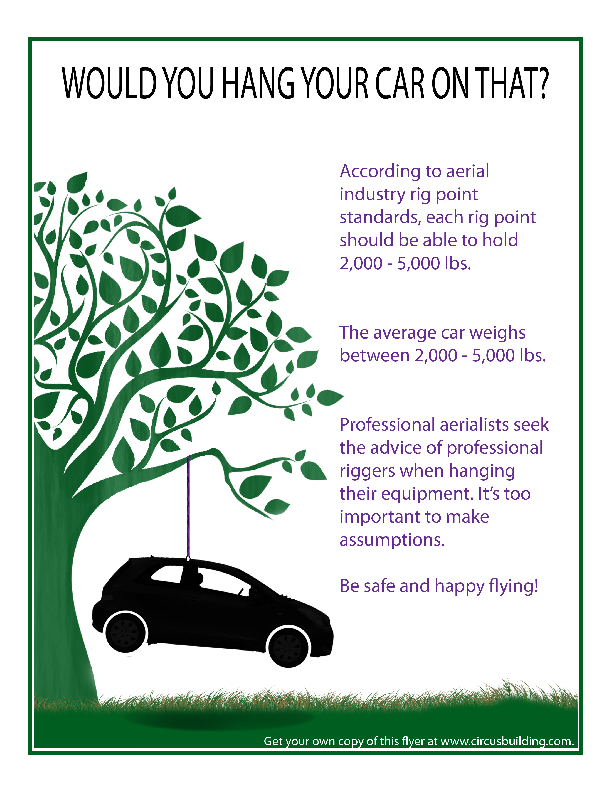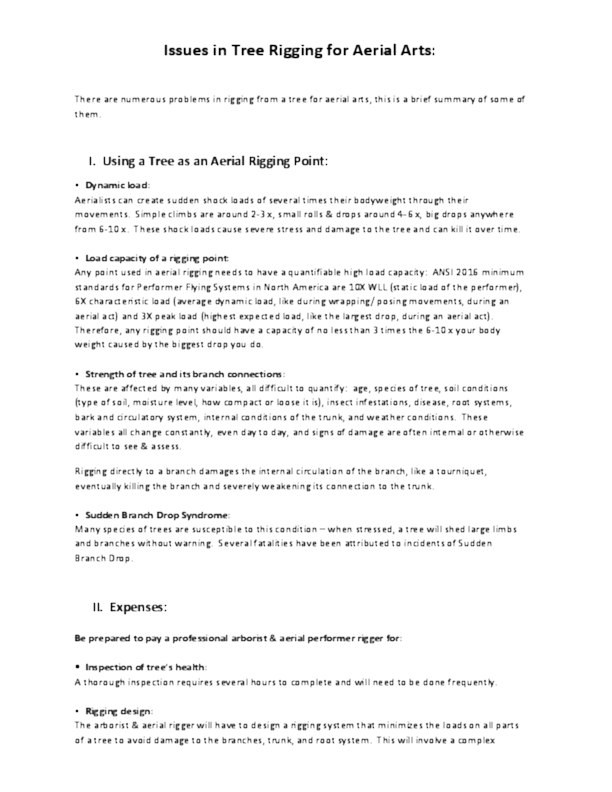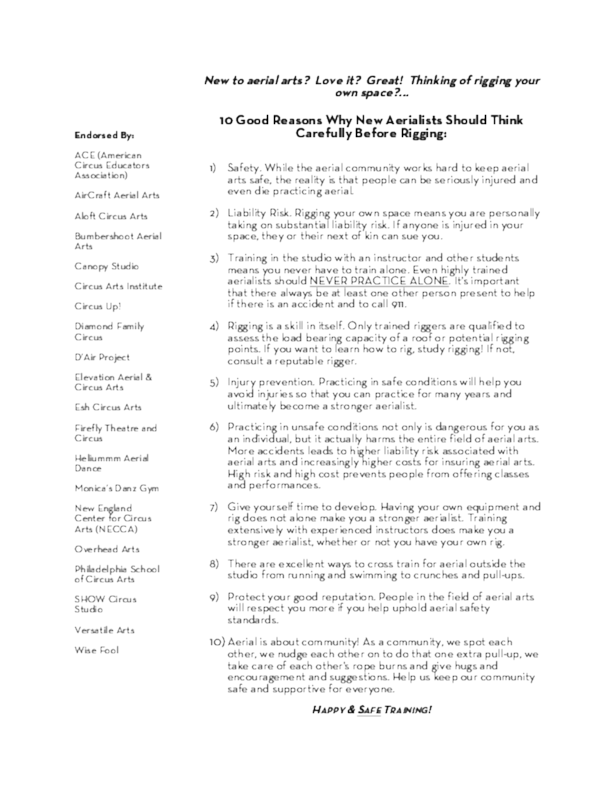
Aerial silks is a highly rewarding practice, and it is easy to see why someone would want to be able to do it at home! During this time of social distancing, it could be even more appealing. If you have or are thinking about purchasing your own silks and rigging for personal use, PLEASE take the time to read the following information. At Origins Family Fitness, we have an engineer rated beam and we use equipment with appropriate ratings that has been purchased from reputable companies and rigged in a manner approved by professionals. We also are insured specifically for aerial training. Our goal is to provide an environment, curriculum, and instruction that allow you to learn this amazing and fulfilling practice in a SAFE way. We take this seriously, and encourage you to do so as well.
The purpose of the following information is not to frighten you, but only to help you to become aware of the many factors that need to be considered, and to gain a healthy respect for possible risks and the steps that should be taken to mitigate those risks.
Here is a document about student rigging, which is endorsed by several reputable groups and companies with years of experience.
Student_Rigging_Guidelines_2014_FINAL
If you are interested in rigging an aerial point in your home, here are some further points you should consider. Remember, anything you rig should be engineer approved for the type of loads it will experience. A beam or truss in your home is already holding up a load, and is likely designed to hold force from above. Is it capable of handling the additional stresses from below, especially including dynamic forces?
The following information is from a worldwide group focused on safety in aerial arts.
Rigging at home –things to consider
The Safety in Aerial Arts group has members who are aerial performer and riggers, and the consensus is that:
* home training in aerials is not recommended if you are a beginner. Your teacher can advise you on suitable strength and conditioning exercises appropriate for your level.
* home rigging is NOT recommended.
* the best solution for home use, or if you are renting,is usually a professionally-designed portable rig that is “rated” (tested and found to be safe) for aerial training.
The reasons that home rigging is not recommended are:
1. REQUIRED TRAINING If you are a beginner, you are unlikely to know how to rig properly. This means determining the forces involved, selecting the correct equipment, installing it and maintaining it.
2. THE FORCES INVOLVED While you may weigh only 60kg/130lb (for example), the act of simply pulling up on a rigging point will exert MORE than your body weight on that point. Any movement on the apparatus will also exert more force than you realize. Try this experiment: Get some bathroom scales and gently stand on them. The needle (if it’s an older one) will ALWAYS shoot past your actual weight, then settle back down again. So any movement you make using the apparatus will be over your body weight, and will be transmitted to the rigging point, repeatedly. This is why rigging points need to be so strong, and to withstand repeated loading -as things often become loose over time.
3.DOORWAY RIGGING Doorway moldings are not designed to carry heavy loads and are rarely high-quality timber. They are usually only nailed onto the studs behind the molding-nails don’t have large heads and the head can tear through a molding very easily.Doorways, due to their width and height, don’t give you enough room to move around on an apparatus.
4. CEILING RIGGING When mounting “from a ceiling”, you need a structural engineer to determine what load your ceiling type can withstand.
For example, ceilings (with wooden or other rafters) are designed to hold load above them, not below them. A wooden trussed roof comprises triangular beams that spread the load of the tiles/metal sheeting/shingles/etc.If you drill through a beam, you weaken it. Domestic ceilings are rarely high enough to enable all movements on an apparatus. Exposed wooden beams are often decorative and not designed to support point loads (loads hung from a single point).
5. WALL RIGGING Attaching loads to walls is possible, but you MUST seek professional advice. In short:* screw-in bolts can tear through the material they are mounted in, especially screw-in bolts into masonry, brick or concrete.
* Masonry walls are designed for loads to be vertically down, not horizontal or outward from the wall.
* Besser block/215s/the grey, hollow concrete bricks often used in industrial buildings or basements are not safe to rig from.They are simply not strong enough.
* Poured concrete, or concrete slab walls MAY be suitable IF the correct fasteners are used -these are usually expanding bolts with a chemical cement that prevents the fastener from pulling out. They need proper (professional) installation.6. INSURANCE Even if you contract a structural engineer to ensure your house structure is safe, and you contract a rigger to install the attachment point(s), your house insurance (or your landlord’s insurance) will usually not cover using the building structure for “aerial” purposes. As there are many insurance policies on the market, it is worth checking your own policy.If you are renting, it is unlikely that your landlord’s insurance would cover such modifications.
7. GENERALLY POOR OR UNKNOWN QUALITY OF EQUIPMENT SOLD ON AMAZON, EBAY, OR AT HARDWARE STORES SUCH AS BUNNINGS IN AUSTRALIA, OR HOME DEPOT IN THE US. Amazon has a known problem with counterfeit products. Products from hardware stores are almost never rated for lifting or supporting people(see below). Some manufacturers have shops on eBay, but you you must check that the eBay listing is actually operated by the real manufacturer. Equipment for performing or training in the air (including rope, cable, chain, fabric/silks, yoga hammocks, aerial apparatus, swivels, carabiners and other mounting hardware) must be rated for aerial use. In simple terms, rating means that the hardware’s failure point has been tested and certified by a laboratory that literally pulls the hardware apart until it breaks. The rating is less than the actual breaking point. The rating, with some exceptions, should be at least 10 times the working load–in the case of aerials, YOU are the working load!
If you weigh 100kg(220lb), then the rating should be 1000kg(2200lb), or about 9800 Newtons (9.8 kN). Many lightweight aluminum swivels, carabiners etc. are rated to 22kn.Stainless steel is stronger, but is heavier and costs more.
8. “BUT I JUST WANT TO DO AERIAL YOGA”. Regardless of whether “aerial yoga” is “aerial” or “yoga”, the emphasis from the Safety in Aerial Arts group is on safety. This comment from Avery Young sums it up:”Circus and yoga are [however] VERY very different. Aerial yoga, “yoga trapeze” and sling assisted stretching are not aerial work. They are yoga, which is a great thing all it’s own, but not the same as aerial arts. The reason so many people are so touchy about this is that there has been great disrespect for aerial arts and the training required for it amongst many in the yoga communities. What you are looking into is something that in particular is known for massive disregard for safety. People can often think “yoga trapeze” qualifies them to skip levels in aerial work, or is less serious and so requires less care. It is also more commercially available and therefore there are many more accidents. Often, this gives the aerial community a bad name, although most professional aerialists are the most safety conscious people out there, and have gone through a lot of training to learn about all the forces involved.In answer to your original question, truly there are only two ways to rig safely at home: 1) purchase a free-standing rig from a reputable vendor OR 2) Hire a structural engineer to determine if your ceiling can handle more load than it is already holding, and if so hire a rigger to safely install a point for you. These will be permanent modifications though, so if you’re a renter, are likely out of the question. The second may also void homeowner insurance so do check into that.Over the door rigs are NOT an acceptable option for this because of the forces generated by human suspension. Even the simplest movements while hanging can double or triple your weight in dynamic force, and most pull-up bar rigs can be dislodged by any sideways momentum. Any other commercially available rigging bases will not be strong enough either (i.e. plates that screw into the ceiling or wall). Please also consider that until you can confidently execute everything on your own, without any cues from your instructor, you’re probably not ready to practice solo. This is a mistake that beginners in many industries can get away with, because their level of potential “catastrophic failure” is much lower. With suspension, your worst case scenarios include permanent injury, paralysis, and death. I don’t mean to discourage you from practicing but rather encourage you to think critically about what it actually is you’re attempting.”
Rigging from Trees
Another option you may have considered is rigging an aerial point from a tree. You may have seen videos on YouTube of aerialists hanging from a tree. A few years ago, I saw some aerial silks hung from a tree in the Cedar City Main Street Park. Rigging from trees used to be fairly common, but in general is emphatically warned against now in the aerial community. Here is further information about rigging from trees. This can help you to understand why it is not a good idea.
If you wish to purchase a portable rig, we can provide you with some suggestions. If you do decide to purchase a rig, there are some further things you will need to consider. Here are a couple of them.
*Your rig will need to be on level ground. Do you have a large enough room or outdoor space that will suit?
*Never leave your silks on an outdoor rig when not in use. Even if you tie your silks to a leg to get it out of the way, there is the very real possibility of the wind catching it and tipping the rig over. You also do not want to expose your silks to the extended weather as this can cause wear, which is a safety issue. This means that you will need to have the means and knowledge of being able to safely attach and remove your silks from the rig.
*ALWAYS practice with an 8″ crash pad underneath you! This is an additional expense, but so necessary!
If a home rig is not a realistic or viable option for you at this time, don’t despair! There are still many things that you can do to increase your abilities and knowledge as an aerialist an home. In fact, even if you are coming to a weekly class, you will progress much faster if you incorporate home “aerial” work into your schedule. We will be sending resources to our students to enable progression from home, and we are always happy to advise you on specific exercises you can do on your own to help you reach your goals.
Much love, and safe flying!


